
Title: Fifty Birds of Town and City
Author: Bob Hines
Peter A. Anastasi
Release date: October 27, 2015 [eBook #50321]
Language: English
Credits: Produced by Stephen Hutcheson, Dave Morgan and the Online
Distributed Proofreading Team at http://www.pgdp.net

U.S. DEPARTMENT OF THE INTERIOR
As the Nation’s principal conservation agency, the Department of the Interior has basic responsibilities for water, fish, wildlife, mineral, land, park, and recreational resources. Indian and Territorial affairs are other major concerns of America’s “Department of Natural Resources.” The Department works to assure the wisest choice in managing all our resources so each will make its full contribution to a better United States—now and in the future.
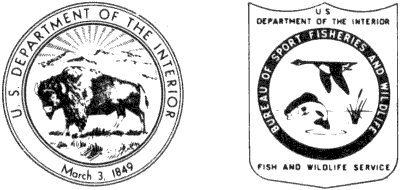
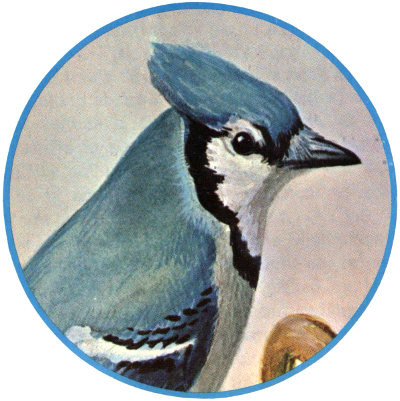
by
BOB HINES
Illustrator-Editor
and
PETER A. ANASTASI
Associate Editor
U. S. DEPARTMENT OF THE INTERIOR
Fish and Wildlife Service
Bureau of Sport Fisheries and Wildlife
Early in this century, the old Bureau of Biological Survey put out a booklet called “Fifty Common Birds of Farm and Orchard,” with paintings by Louis Agassiz Fuertes.
In 1962, a former Fish and Wildlife Service staffer named Rachael Carson wrote “Silent Spring,” a book that changed American thinking about birds—and pesticides.
That first volume is out of date because of our great population shifts in six decades. And I hope that “Silent Spring” will be out of date some day; that our birds will live with us in an unpoisoned environment of cities and towns that are cleaner, healthier, greener.
So here is a new “bird book” from the Department of the Interior, geared to the 50 birds you might see in your city, with paintings done by a man who picked up the fallen Fuertes brush, Bob Hines. These are not endangered birds, except as all living things are endangered; some of them are living in or passing through your backyard or city park right now. Look well at Bob’s art; he is not commemorating the passenger pigeon but trying to open your eyes to the world about you.
And he is trying to suggest that these birds can live in our towns and cities so long as you help provide the healthy habitat they need, habitat that is healthy not just for them but for you.
Enjoy this little book, learn from it, and take a vow that our springs will not be silent of bird calls—and will be more silent of human clatter.

Secretary of the Interior
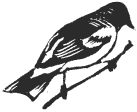

Look for this bird in groves and shade trees in residential areas of towns and suburbs. Smaller than a robin, the male’s fiery orange and black is easy to spot. As he wings by, his bright colors add a flick of glory to the urban scene.
The song is a rich series of whistled notes. Wintering to South America, the oriole’s summer breeding range stretches from Nova Scotia to north Texas. This is the architect of the graceful pendulent nests usually seen only after the leaves have fallen, and the birds have gone.

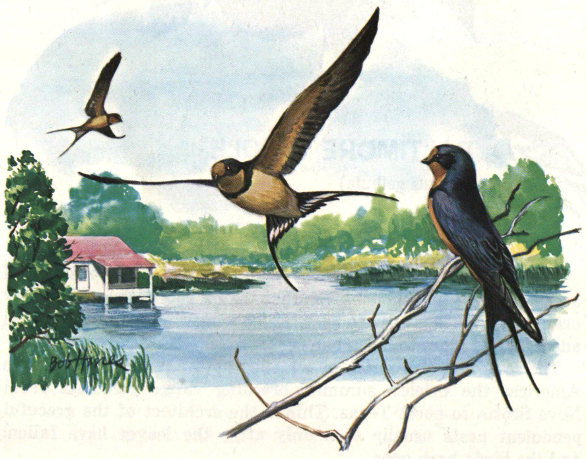
Length about 7 inches; distinguished among our swallows by deeply forked tail. While they breed throughout the United States, they winter to South America.
This is one of the most familiar farm birds and a great insect destroyer, seeking prey from daylight to dark on tireless wings. Its favorite nesting site was barn rafters, upon which it stuck mud baskets to hold its eggs. But modern barns are fewer and so tightly constructed that swallows can not gain entrance, and in much of this country they have turned to boat docks, commercial buildings, summer homes, and the out buildings of rural suburbs to keep the species going. Like other rural birds, they have to adjust to changing land-use patterns.
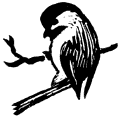
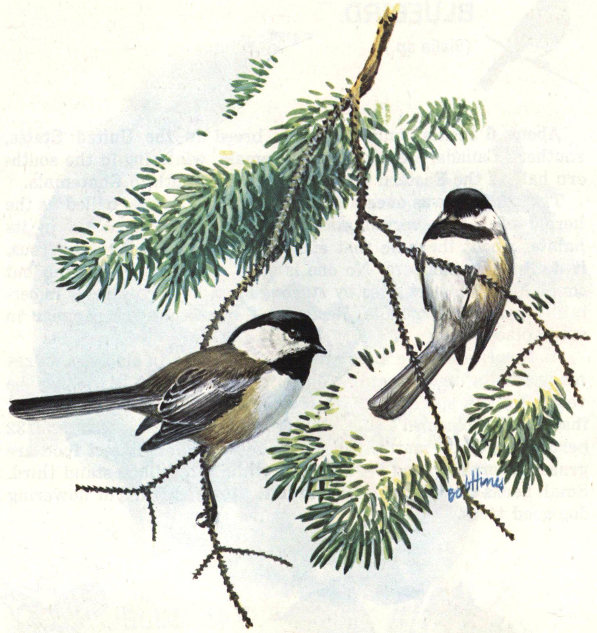
Length about 5 inches. Resident in most of North America.
Because of its delightful notes, its flitting ways, and its fearlessness, the chickadee is one of our best known birds. It responds to human encouragement, and by hanging a constant supply of suet this black-capped visitor can be made a regular feeder in suburban gardens or city yards. Though small in size, these cousins of the titmice are highly useful against insects, gleaned mostly from the twigs and branches of trees. The chickadee’s food is made up of insects and seeds, largely seeds of pines, with a few of the poison ivy, some weeds, and sunflowers.

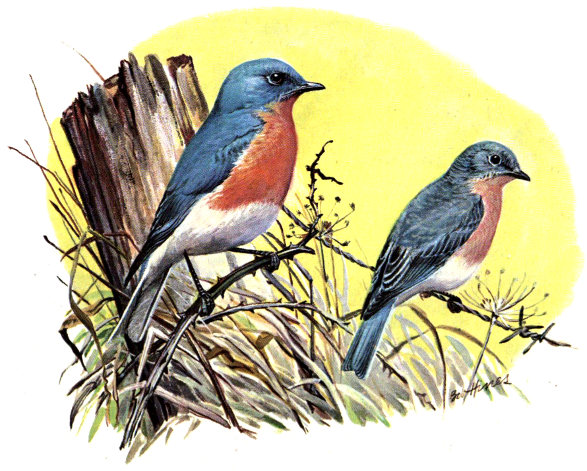
About 6 inches long, bluebirds breed in the United States, southern Canada, Mexico, and Guatemala, wintering in the southern half of the Eastern United States and south to Guatemala.
The bluebird was once a familiar tenant of towns, hailed as the herald of a new vernal season, and decidedly domestic in its habits. About the time that starlings became so very numerous, it declined in numbers. No one is sure why its numbers fell but competition for nest sites by starlings and house sparrows is certainly partly responsible. Recently it has begun to reappear in many places.
Its favorite nesting sites are natural cavities in old trees, boxes made for its use or crannies in buildings. Nesting boxes may be restoring the species, whose occupants pay rent by destroying insects. The bluebird’s diet consists of 68 percent insects and 32 percent vegetable matter. The commonest items of insect food are grasshoppers first and beetles next, while caterpillars stand third. Small flocks sometime invade yards for the red fruits of flowering dogwood trees.

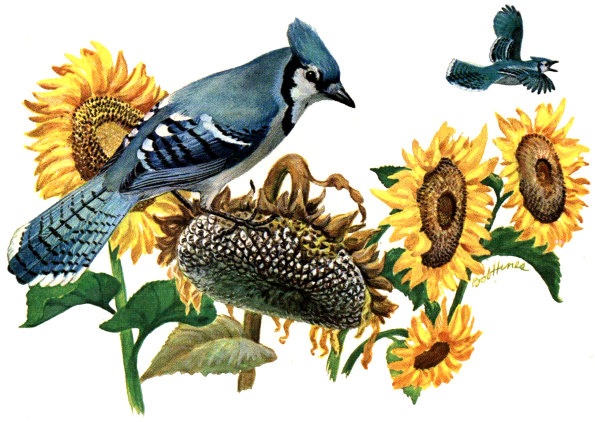
You either admire or hate this arrogant, foot-long hustler, easily identified by its brilliant colors. The blue jay is resident in the eastern United States and southern Canada, west into the Dakotas, Colorado, and Texas.
Like most insolent creatures, this jay has a dual nature. Cautious and silent in the vicinity of its nest, it is bold and noisy away from it. Sly in the commission of mischief, it is ever ready to scream “thief” at anything poaching on its domain. As usual in such cases, its epithet is applicable to none more than itself, as neighboring nest holders know to their sorrow; for during the breeding season the jay lays heavy toll upon the eggs and young of other birds. But with all its sins of pride and lust, back yards are enlivened by the presence of blue jays.

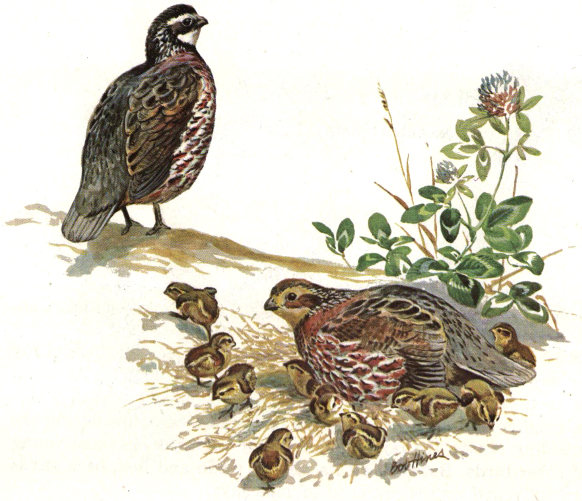
This quail, about 10 inches long, is known by the clear call that suggests its name. It is native in the United States east of the Rockies and has been introduced many places in the West.
The bobwhite, and its call, is loved by every countryside visitor. It is one of the most popular game birds and appreciated as a gourmet’s delight. Quail have moved into our suburbs, although its numbers have diminished in many States through loss of habitat. About half the food of bobwhites consists of weed seeds, a tenth of wild fruits, and a fourth grain. Most of the grain it consumes is picked up from stubble. Fifteen percent of the bobwhite’s food is composed of insects, including several of the most serious pests, but its greatest value is aesthetic.
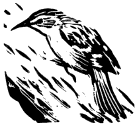
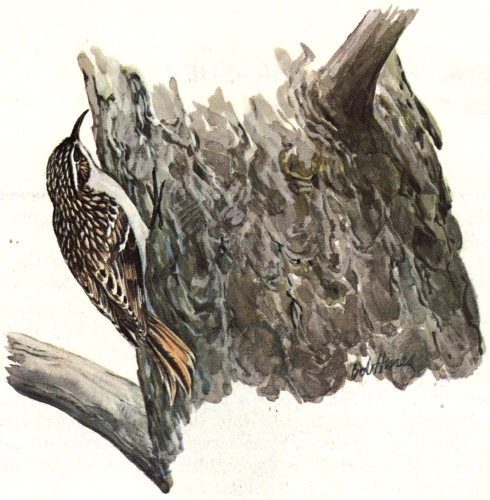
Length 5 inches. Breeds from Alaska and Canada south to the Great Lakes States and Connecticut; also in the mountains south to Nicaragua; winters over most of its range.
Rarely indeed is the creeper seen at rest. It appears to spend its life in an incessant scramble over the trunks and branches of trees, gleaning its insect food. It is so protectively colored as to be practically invisible to its enemies and though delicately built possesses strong feet and claws. Its tiny eyes are sharp enough to detect insects so small that most other species pass them by. The creeper fills a unique place in the ranks of our insect destroyers: minute insects, their eggs and larvae, moths, caterpillars, small wasps, scales and plant lice are items of its diet.
It does not appear in flocks. Single birds or pairs will feed infrequently on beef suet at bird stations, but it’s seldom a regular visitor.
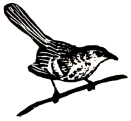
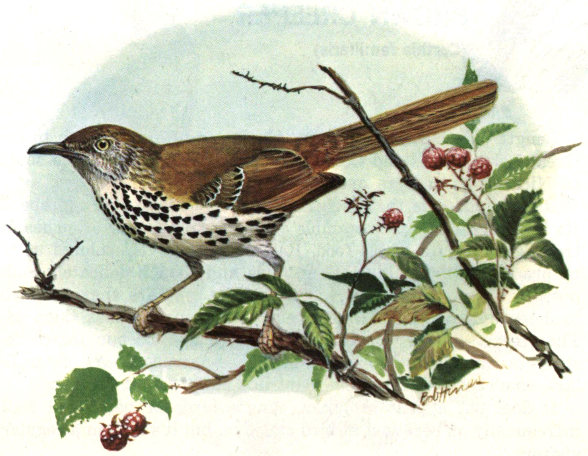
About 11 inches. Breeds from the Gulf to southern Canada and west to Colorado, Wyoming, and Montana; winters in the southern half of the eastern United States.
The brown thrasher is more retiring than either the mockingbird or catbird, but like them is a splendid singer. Not frequently, indeed, its song is taken for that of its more famed cousin, the mockingbird. It is partial to thickets and gets much of its food from the ground. Its search for this is usually accompanied by much scratching and scattering of leaves; whence its common name. Its call note is a sharp sound like the smacking of lips, useful in identifying this long-tailed, thicket-haunting bird, which does not relish close scrutiny. The brown thrasher is not so fond of wild fruit as the catbird and mocker, but devours a much larger percentage of animal food.
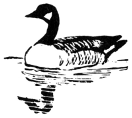
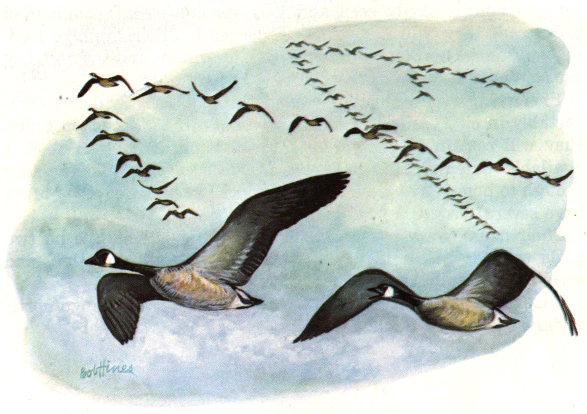
This most familiar and most common of the wild geese is best known in urban areas as a visitor in spring and fall.
Sizes vary, but the head and neck markings make this goose easily identifiable. The Canadas breed on lake shores and coastal marshes, primarily in Canada, and migrate in organized units utilizing the well known V-formation, although sometimes flying in long strings of birds. Flying by day and night, Canadas have set down in flocks on city squares, apparently mistaking a pool of light for a water surface. They seldom live in cities or towns, although visiting urban parks on occasions. Their honking cries in migration have stirred the blood of many an urbanite on a fall night when traffic noises let the wild cry from the skies leak through.
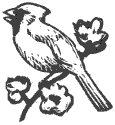
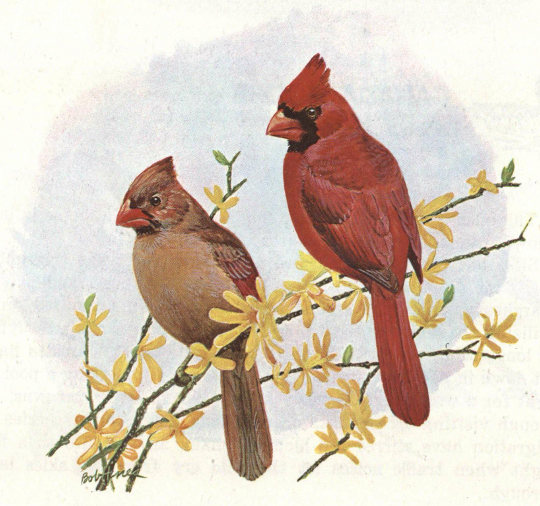
Color alone would make cardinals favored birds. Their striking plumage is easily seen and long remembered. Though mild mannered, they will sometimes chase each other from a feeding station in early winter, but by late winter and spring they eat side by side.
Preferring vines, shrubbery, and thickets, they will live comfortably in city yards and parks. Since cardinals do not migrate, they will remain in one yard the year round, as long as food is available. Often nesting in bushes beside busy sidewalks, or near enough to homes that their every move can be watched, they often have several broods a year.
Their usual song is a clear and ringing whistle. While no two birds seem identical in sound, their songs are distinctive, and once learned, will always bring pleasure.
These fine birds are now found in most states, and range north as far as southern Canada.
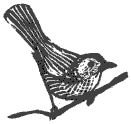
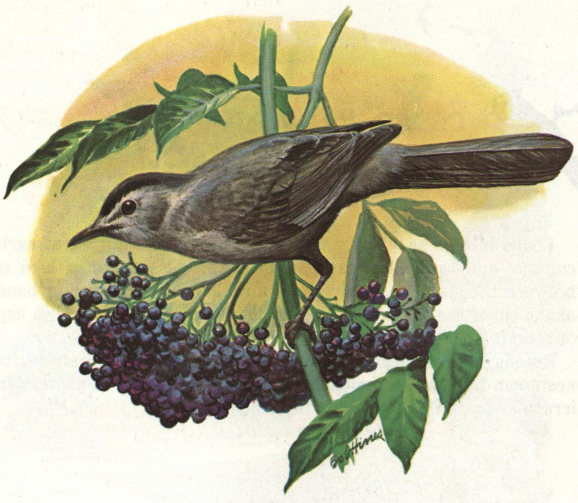
Length about 9 inches; the slaty gray plumage and black cap and tail are distinctive. Breeds throughout the United States west to New Mexico, Utah, Oregon, and Washington, and in southern Canada; winters from the Gulf States to Panama.
In some localities the catbird is fairly common. Tangled growths are its favorite nesting places and retreats, and ornamental shrubbery around houses will attract and keep them inside a town. The bird has a fine song, frequently broken by mewing like a cat. Its habits are somewhat similar to those of its cousin, the mockingbird, with song almost as varied, but it is more secretive and usually sings while hidden in the bushes. It feeds on fruit and insects, and can be lured to shelves and windows by raisins, cherries, or chopped apples.
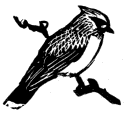
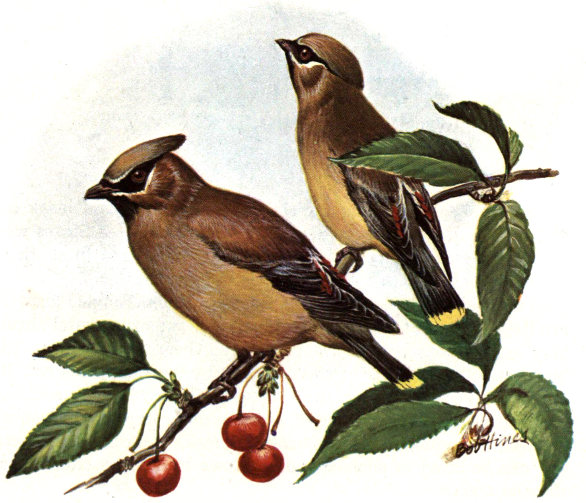
Found in open or bushy woodlands or along the margins of agricultural and residential areas, this sleek, crested brown bird is between the size of a sparrow and a robin. The broad yellow band at the tip of the tail is conspicuous and its voice is a high, thin lisp or zeee. It is the only sleek brown bird with a long crest.
Breeding from Canada to north Georgia and west to Kansas, its nests can be fairly common in suburban areas, and it winters in irregular patterns throughout the United States.
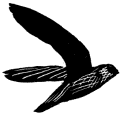
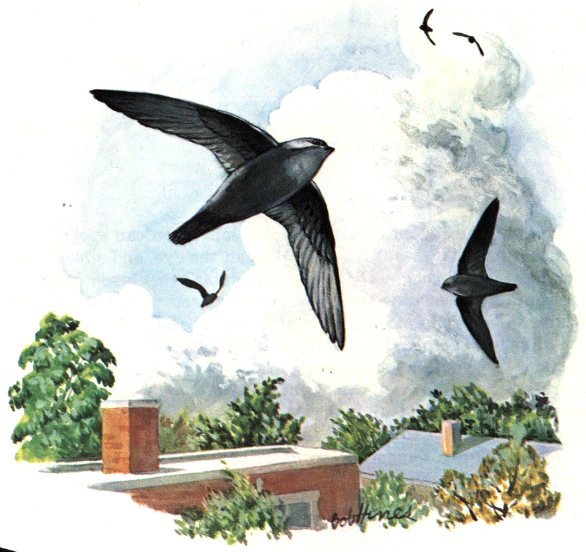
It’s hard to figure out how these birds ever existed without urban areas, since they literally earn their first name by nesting and roosting in chimneys, propping themselves against the inside surface with short, spiny tails.
This swift is normally found only east of the great plains. Small birds at about 5 inches long, they are aloft all day long, and almost always in groups. They migrate in large flocks and nest from Canada to the Gulf of Mexico. Watching a flock of swifts flow funnel-like into a chimney is a startling evening experience. The birds express themselves with a chatter of chipping cries, one of the easiest identifications of the species. Their only food is insects, and they are highly beneficial.
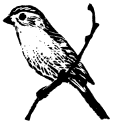
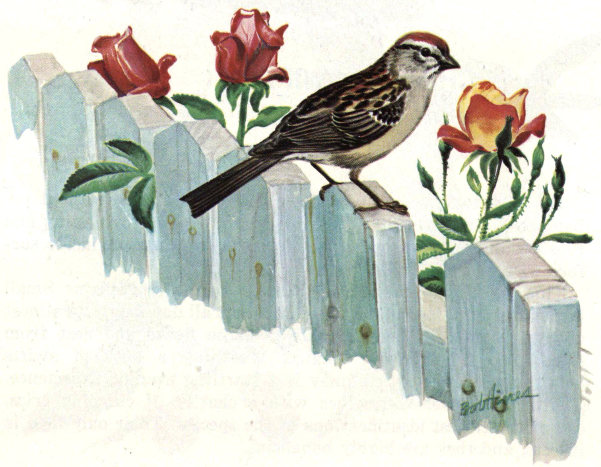
This slim bird is only about 5 inches long. You can spot it by a chestnut brown crown, black line through the eye, and a black bill. Chippies nest throughout the United States; they even breed as far south as Nicaragua and as far north as southern Canada, and winter in the southern United States and Mexico.
Chipping sparrows are domestic birds that show little fear of humans. They often build nests in gardens, cemeteries or golf courses, where mowed lawns provide feeding areas. Among the most insectivorous of all sparrows, their diet consists mainly of insects, supplemented by weed seeds.
Adjectives are dangerous in describing wildlife, but chippies are just plain lovable.
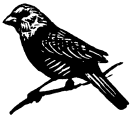
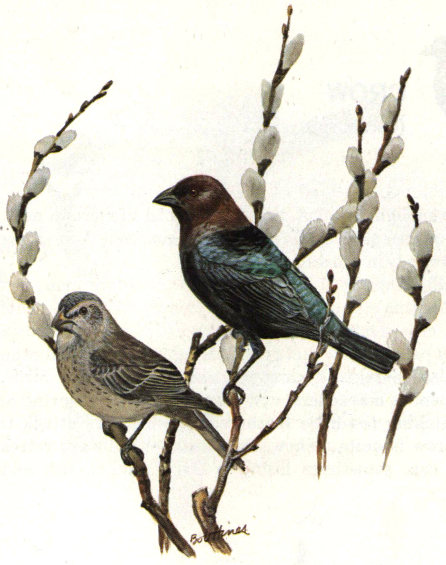
Cowbirds are the only native American birds to always lay their eggs in nests of other species, and have the young raised by foster parents. Warblers, finches, and sparrows, all smaller than cowbirds, are the chief victims of this practice, the fast growing foster chick monopolizing food and space to the detriment of the legitimate offspring.
This is the smallest blackbird, flocking in small groups, or mixing with grackles and red-wings. They are usually quiet, their only song a faint whistle. They range north into Canada and winter in the southeastern States. Grasshoppers, beetles, and a number of insects are eaten, and like other blackbirds, they do some damage to grain.
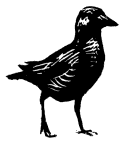
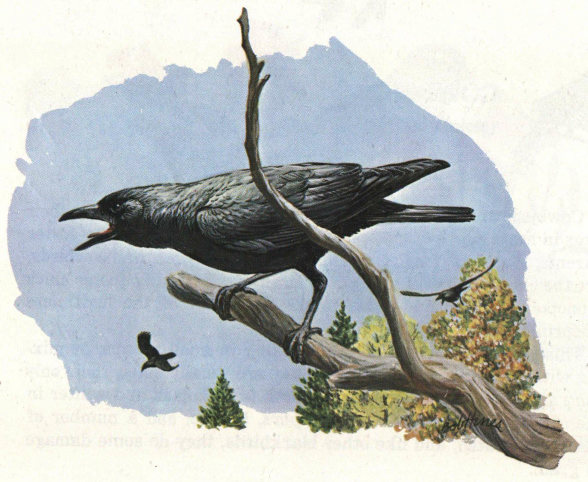
Smart enough to adapt quickly to urban life, crows nest in such unlikely places as alongside the Pentagon, and feed in the White House grounds in Washington.
Typically, they feed in the early hours before many people are out, retreating to parks or fields when disturbed. Their nest-robbing, crop destroying habits are often exaggerated, and less attention paid to their diet of grubs, beetles, mice, and other pests.
Grackles, martins, flycatchers, and other smaller birds, recognizing them as marauders, will chase crows in the spring and summer. Watching the little feathered dive-bombers attack the lumbering crow is quite a show, the larger bird always retreating as best he can, sometimes losing a few feathers, but seldom his dignity.
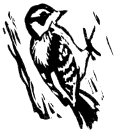
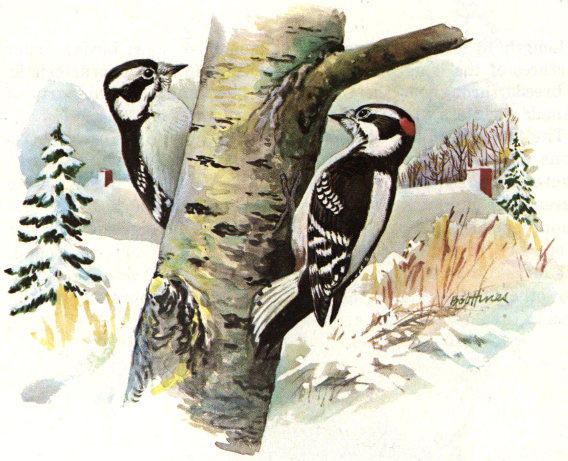
Our smallest woodpecker at 6 inches; spotted with black and white. Dark bars on the outer tail feathers distinguish it from the similar but larger hairy woodpecker. Resident in the United States and the forested parts of Canada and Alaska.
This woodpecker is widely distributed, living in woodlands, orchards and gardens. Like the hairy woodpecker, it beats a tattoo on a dry resonant tree branch. To appreciative ears it has the quality of forest music. In a hole excavated in a dead branch the downy woodpecker lays four to six eggs. This and the hairy woodpecker are valuable human allies, their food consisting of some of the worst insect foes of orchard and shade trees. Beef suet, fastened too high for dogs to pirate, will attract Downies to a feeding station.
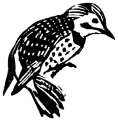
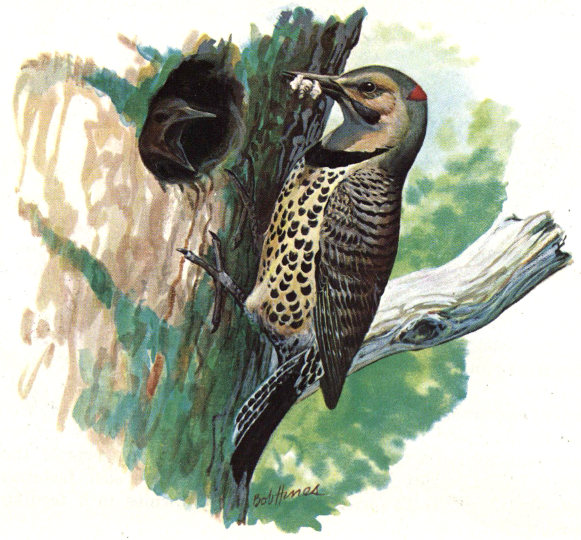
Length 13 inches; the yellow (salmon in western birds) under surfaces of the wing and tail, and white rump are characteristic. It breeds throughout the United States and in forested parts of Canada; winters in most of the southern United States.
The flicker inhabits open country and delights in parklike regions where trees are numerous but well-spaced. It is possible to insure the presence of this useful bird about the home and to increase its numbers. It nests in any large cavity in a tree and readily appropriates an artificial nesting box. The most terrestrial of our woodpeckers, it procures much of its food from the ground. The largest item of animal food is ants, of which it eats more than any other common bird. The flicker is more adapted to suburbs than to the larger cities.
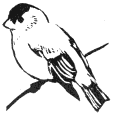
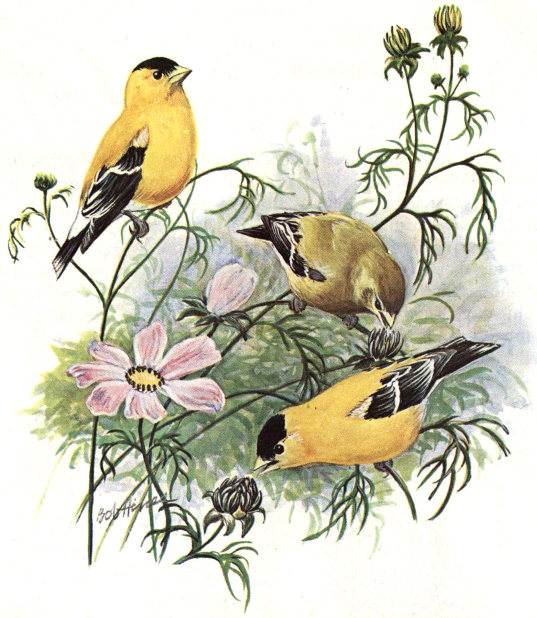
The male is the only small, yellow bird with black wings and tail, with flight that is extremely undulating. In winter the species concentrate in areas where seed-laden plants are common.
They breed from Canada to Mexico and winter in the same range, nesting in July and August, after most birds have finished. The song is long-sustained, clear, light, and canary-like. In its flight, each dip is often punctuated by a simple cry of ti-dee-di-di.
Goldfinches are found along hedgerows, wood margins, brushy fields, and flower gardens, especially where cosmos are growing.
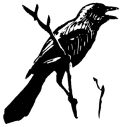
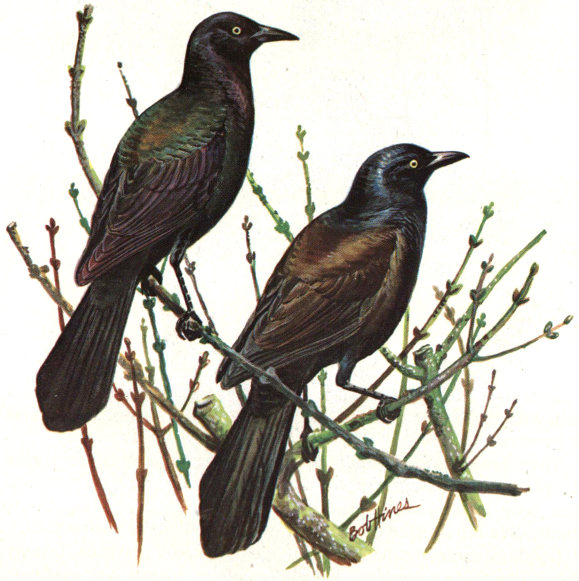
Length 12 inches. It breeds throughout the United States west to Texas, Colorado, and Montana and in southern Canada and winters in the southern half of its breeding range.
This is a beautiful blackbird that is well known from its habit of congregating in city parks and nesting there year after year. Like other species which habitually assemble in large flocks, it is capable of inflicting damage on farm crops. It shares with crows and blue jays a habit of pillaging the nests of small birds, but it does much good by destroying garden pests, especially white grubs, weevils, grasshoppers, and caterpillars.
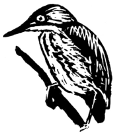
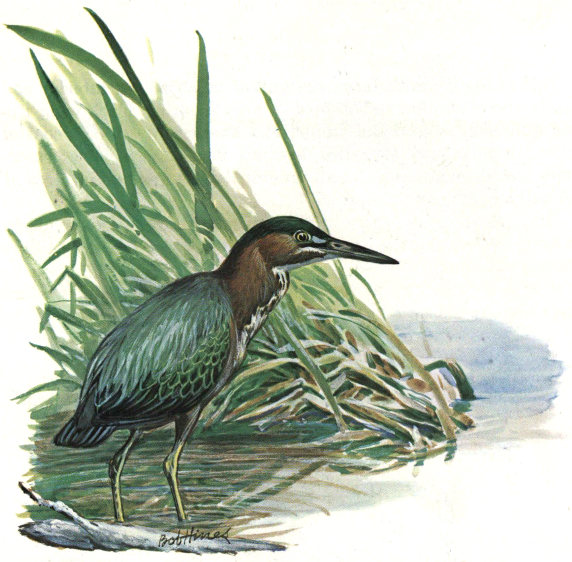
A small, dark heron common to all water areas, breeding in a combination of wooded or brush habitats and marshes. It is also found along the wooded margins of lakes and ponds. It often shows more blue than green and is easily confused with the little blue heron. Its flight appears crowlike at a distance, moving with slow, arched wing beats.
The most generously distributed of small herons, its series of “kucks” or its loud skyow can often be heard in areas near urban settlements.
It breeds from the Gulf of Mexico north to southern Canada and winters from Florida south.
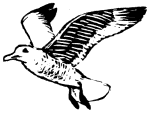
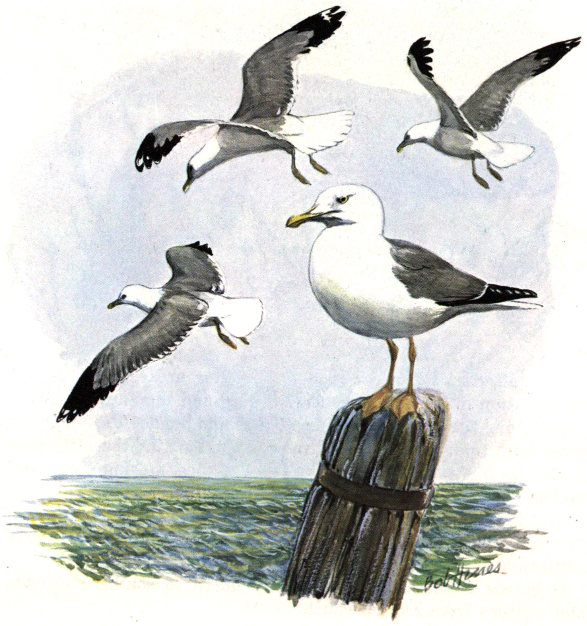
This is the common large sea gull of much of our interior and coasts and a familiar urban bird; a gray mantled, black wing tipped gull seen in garbage dumps and harbors in all U.S. coastal cities. Oceans, bays, estuaries, beaches, fields, inland lakes, reservoirs and large streams ... all provide habitat for this inspirer of “Jonathan Livingstone Seagull.”
His free wheeling grace in the sky and his raucous yet lonely kee-ow, ke-ow manage to bring beauty to even the most odoriferous city dump.
It breeds from the Arctic to the northern states and winters from the Great Lakes to the Gulf of Mexico.
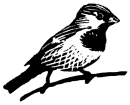
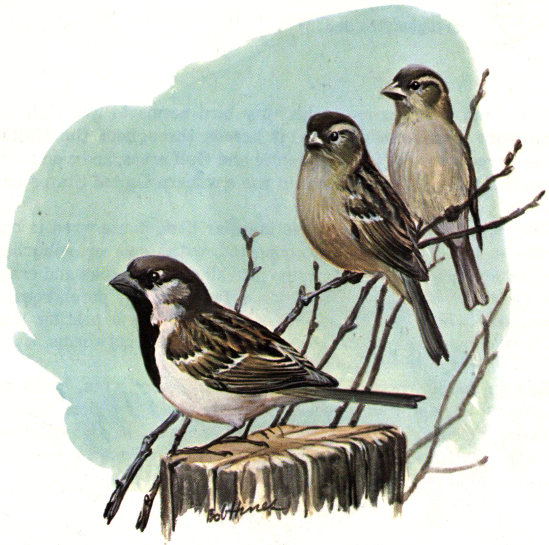
Perhaps the most citified of birds, this import’s incessant chattering, quarrelsome disposition, and abundance about human habitations distinguish it from our native sparrows. Actually, it is not a sparrow at all, but a weaver finch.
Almost universally condemned after its introduction into the United States, the house sparrow not only held its own, but increased in numbers and extended its range. It now occupies its own niche and is regarded with amusement and considerable affection in our inner cities.
In rural areas it does some damage to fruit, vegetables, and grain. On the other hand, it also eats a number of insects that damage those same crops.

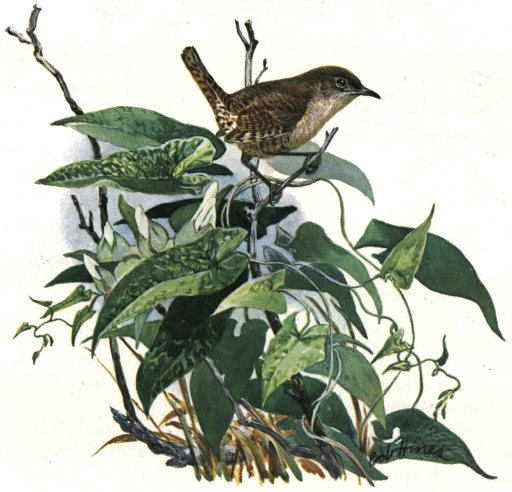
Less than 5 inches long, this tiny bird seems to live right at home with a man-made house. It breeds throughout the United States, except for the South Atlantic and Gulf areas, and also nests in southern Canada. It winters in the southern United States and Mexico.
The rich, bubbling song of the familiar little house wren is one of the sweetest associations connected with town or suburban life. Its tiny body allows it to creep into all sorts of nooks and crannies for its insect food. A cavity in a fence post or porch roof, a wren box, a hole in a tree, will be welcomed as a nesting site. Their food is grasshoppers, beetles, bugs, spiders, cutworms, ticks, and plant lice.
Recognized universally as Johnny and Jenny wren, welcome neighbors, they still show peculiarities in their behavior. Jealous of their home areas, wrens sometimes puncture the eggs of other small species nesting nearby, and Johnny may have two, possibly three mates at one time.
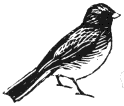
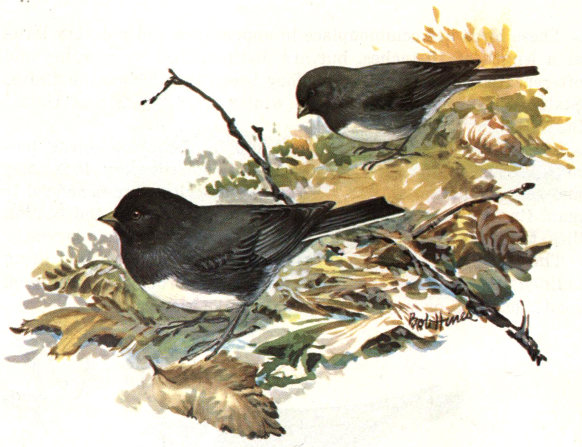
A dark, slate-gray sparrow with conspicuous white outer tail feathers and a white belly. An abundant species, it breeds in brushy, cutover forests and is usually seen by urban dwellers when transient or wintering flocks come into residential areas. Juncos often winter at feeding stations in cities, suburbs, or towns.
It breeds from the tree line south to the northern states, farther south in the mountains. It winters in most of the U.S.
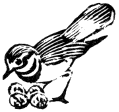

These birds are commonplace in appearance and not very large at a length of 10 inches, but are distinguished by piercing and oft-repeated cries of “kildee.” They breed throughout the United States and most of Canada, and winter from the central United States to South America.
The killdeer is probably the best known of the shorebirds, perhaps because of its contrasting colors and startling cry. It is noisy and restless, like people, but most of its activities are beneficial to man. Its food is harmful insects, particularly weevils and beetles, flies, ticks, and wondrously enough, mosquitoes and their larvae.
The four pointed eggs are marked like pebbles, and laid in an unlined depression on the ground. Such dangerous sites as gravel roads, quarries, or even potato patches have been used.
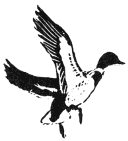

One of the largest ducks, mallards range across the entire northern hemisphere, and are probably the best known of all waterfowl, likely to set down in migration on small pools in city parks. It has also been widely domesticated or semidomesticated.
Its coloration makes identification easy, and the loud quack helps identify it. The birds breed in prairie waterholes in Canada, the Dakotas, Minnesota, and, to a minor extent, in other northern States. They move with the great spring and fall migrations and, adjusting easily to the presence of man, are likely to be seen in town or city. Add the domesticated mallards that swim about in so many parks and you have the most urbanized of the ducks that can still claim a wild heritage. They are most abundant in the Mississippi Valley.

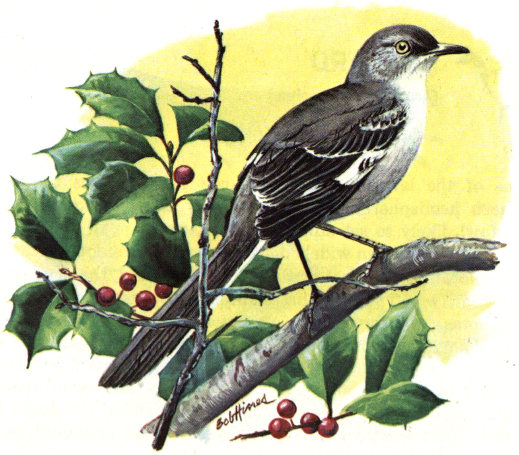
Ten inches long and neatly but soberly feathered, this was the bird of the Old South, but it is resident now from southern Mexico north to Michigan, Maine, even up to Wyoming, and seems to be spreading farther.
Because of its incomparable medleys and ability to mimic other birds, whistles, clocks, and bells, the mockingbird is the most renowned singer of the Western Hemisphere. Even in confinement it is a masterly performer, and in the nineteenth century, many were trapped and sold for cage birds. This practice ceased long ago, under law and close scrutiny. Mockers will feed on cultivated fruits, but they have so won human affection that this is rarely charged against them—principally because of that reputation as a songster and the fact that they eat a variety of destructive insects.
Raisins, oranges, or apples will bring them to a feeding station. To prevent them driving all other birds away from your tray, it helps to put the mocker’s rations at a distance, preferably across the yard, or on the opposite side of the house.

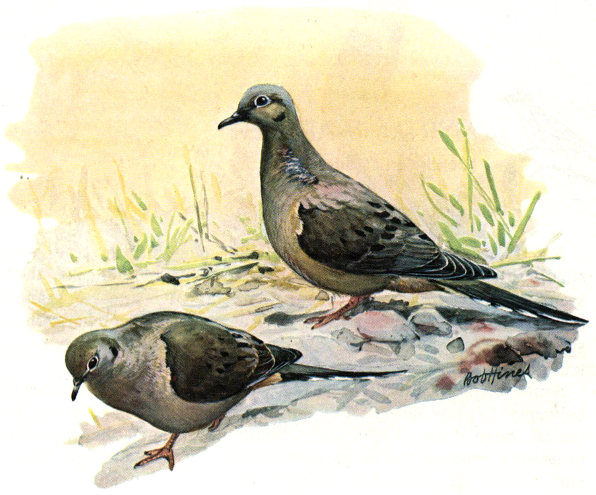
A dark spot on the side of the neck distinguishes this bird from other native doves and pigeons except for the white-wing of the southwest. Also known as turtle dove, the “mourner” frequently nests in suburban and city shrubbery throughout the United States, Mexico, and southern Canada; it winters from the central United States to Panama—and is part of folklore in all those countries.
Mourning doves eat the seeds of plants, including grain, plus berries and the small wild fruits of any region through which they pass. Despite that melancholy but peaceful “coo,” they are restless migratory creatures. Doves live in the large cities, small towns, villages, and countryside; songs are sung and poems written about them; they are esteemed game birds that may nest in trees in your yard.

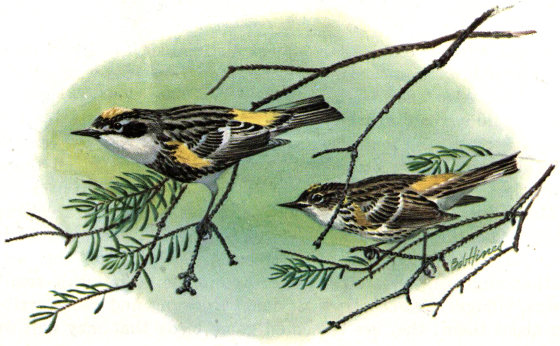
Myrtle warblers are tiny mites that liven up the trees and shrubs in the spring migration. Traveling in small flocks, they seem to be constantly in motion, flitting from branch to branch searching for small insects and their eggs. Like flycatchers, they snap up larger bugs on the wing. To a quiet observer, they seem trusting birds, often singing at close range.
Some winter as far north as the New England coast, wherever bayberry thickets offer fruit and shelter, and others move on to the southern states. From these wintering grounds they migrate to nesting grounds in the evergreen forest of the northern states and Canada. In their fall flight south, they seem subdued, the bright yellow on the crown and flanks having disappeared, and the lemon colored rump the only remaining brilliant.


Often seen on dull days as well as dawn or dusk, the long slender wings of nighthawks exaggerate their size. They are 10 inches long, but seem bigger.
At rest, they perch lengthwise on branches, crossarms, or logs, or on the ground. In the air, their flight is a series of fluttering spurts, followed by long glides. Before aviators broke the sound barrier, nighthawks had their own ‘sonic boom,’ created by diving vertically from considerable height and flaring sharply upward near the ground.
Flying insects, from mosquitoes to beetles and moths, are their only food. Nighthawks build no nest, the two young being raised on the bare ground, or flat roofs.
Nighthawks nest in all states except Hawaii and winter in South America.

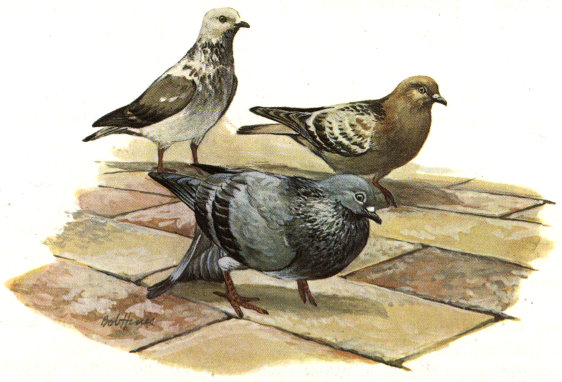
The common pigeon found in all U.S. cities is a descendant of the wild European rock dove that was introduced domestically in this country early in our history. Living and breeding in cities and suburbs, it is a permanent year-round resident and often is so populous as to be a nuisance, fouling building ledges, park benches, statues, and occasionally people.
Feeding the pigeons in city parks is an old custom, particularly for the young and old. This bird is probably the one most familiar and recognizable to the urban dwellers and may be their closest contact with the world of birds.
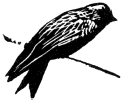

These birds breed throughout the United States and southern Canada, and down to central Mexico. They winter in South America.
This is the largest (8 inches long) of the swallow tribe. It formerly built its nest in cavities of trees and still does in wild districts, but having learned to live close to humans, it soon adopted domestic habits. The best way to have martins around is to erect apartment houses for them at suitable nesting sites—and protect that housing from use by other birds. The nest boxes should be about 15 feet from the ground and made inaccessible to cats. A colony of martins makes great inroads upon the insect population, as the birds not only feed upon insects but rear their young on the same diet.
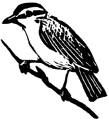
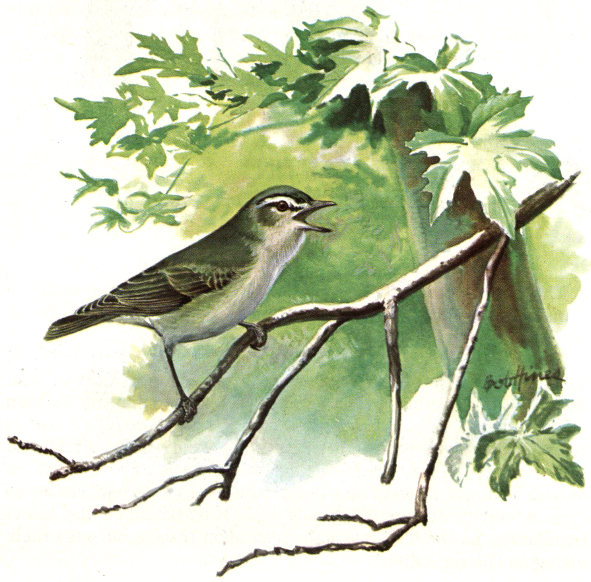
The red eye of this small olive-green and white bird, although giving it a name, is of little help in identifying it. Abundant in eastern forests in its breeding season, it winters in South America. This bird is seen in deciduous trees in city parks during migration.
Its call is a monotonous series of short, abrupt phrases similar to a robin’s. It is repeated as often as 40 times a minute, all through the day. It is lucky for suburban sleepers that the vireo doesn’t sing at night.

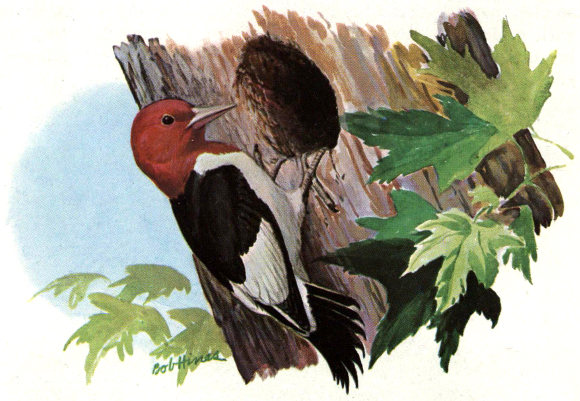
At 9 inches or so in length, this is a medium-sized woodpecker which occurs in the eastern states.
The red-head isn’t really common even in its announced range, although it’s easy to spot when it is working the neighborhood. It likes open, deciduous woods, parklike spaces, and is fond of cities where old trees line the streets. Like all its clan, its diet of harmful grubs, beetles, and other insects makes it a desirable bird, and the small amounts of fruit and acorns it eats are never missed.

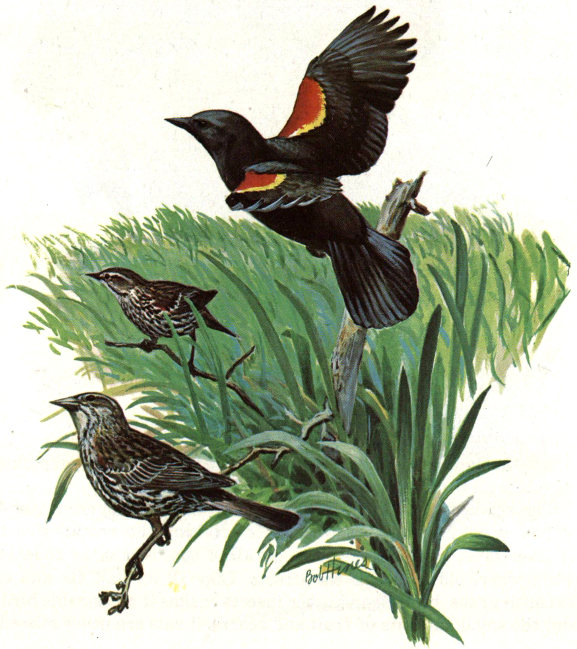
About 9½ inches long, the red-wing breeds in most of North America; it winters in the southern half of United States and down clear to Costa Rica.
The prairies of the upper Mississippi Valley, with their numerous sloughs and ponds, furnish ideal nesting places for red-wings, and this region has become the great breeding ground for the species, pouring forth the vast flocks that sometimes play havoc with grainfields. Red-wings are gregarious, living in flocks and breeding in communities. Their food is about one-fourth insects and three-fourths vegetable.
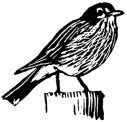
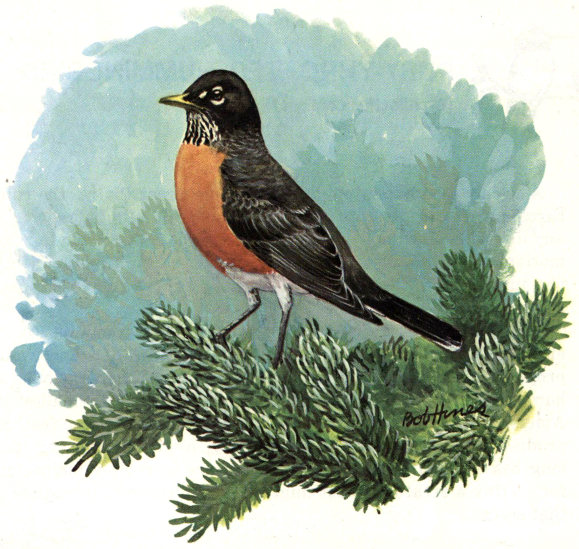
Probably the best known of the United States birds, and widely believed a harbinger of spring, adults are 10 inches long. They breed in the United States and Canada, and winter in most of the United States, ranging south to Guatemala.
One of the most cherished of our native birds, the robin is an omnivorous feeder. While its food includes many worms and insects, it is especially fond of fruit, particularly cherries, mulberries, and strawberries. Like the bluebird, it is a thrush.
Highly adaptable, it is friendly and trusting in cities and towns, and wild and distrustful of man when living in wilderness areas.
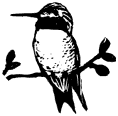
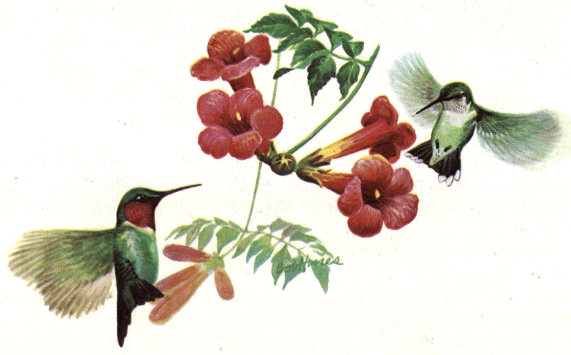
A widely seen hummingbird east of the Great Plains, the ruby-throats are exquisite bits, capable of incredible flight, moving in any direction on wings vibrating faster than sight or able to hover motionless while spectators are breathless. They are plentiful—one just shouldn’t use the word “common” about this lovely pulse of bright energy.
They sup on nectar from garden flowers or blossoming “weeds” and are attracted to yards or gardens by tubes of sugar water properly hung. And they eat insects. Several other varieties of hummingbirds live in the West and all are tiny—smallest of American birds—and beat their wings so rapidly that the feathers produce a hum. All hover while feeding, mostly by dipping their long beaks in flowers, and all of them are incredibly pugnacious for so tiny a creature. Most migrate long distances, incredible as that seems.
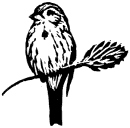

This is the most widely distributed of all our native sparrows, appearing in one form or another from Florida to Alaska and range in color from pale to dark brown.
They love water and are most numerous where streams, ponds, or marshes offer dense cover, but yards with shrubs and vines will attract them.
Their space requirements are small. A pair will live and nest in 1½ acres or less. They nest on or near the ground, both parents help raise the young, and they raise up to four broods a year. Cowbirds often lay eggs in their nests, and are considered with dogs, cats, and rats as their greatest enemies.
There are many sparrows with spotted breasts, but the heavy dot in the center of the chest and the streaks on breast and flanks distinguish this bird from others.
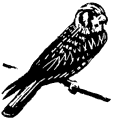

Length about 10 inches; one of the best known and handsomest, as well as smallest, of North American hawks. Breeds throughout the United States, Canada, and northern Mexico; winters in the United States and south to Guatemala.
The sparrow hawk, a true falcon, lives in the more open areas and builds its nest in hollow trees. It is often found where telephone and power poles afford it convenient perching and feeding places, and may be seen hovering high over its intended prey. Its food consists of insects, small mammals, birds, spiders, and reptiles. Grasshoppers, crickets, terrestrial beetles, and caterpillars make up considerably more than half its subsistence, while field mice, house mice, and shrews cover fully 25 percent of its annual supply.
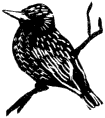
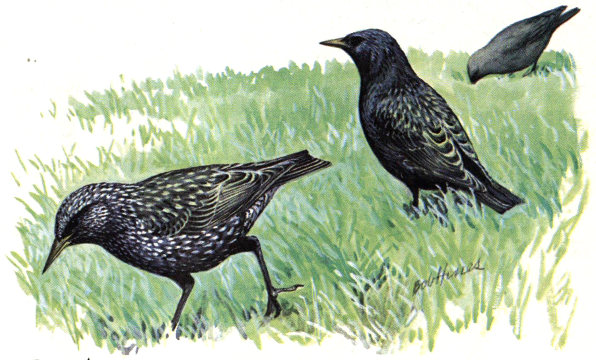
There are few people in the United States who have not seen starlings, even though the viewers might not know the label. Introduced into this country in the 1880’s, they took hold rapidly and became permanent residents everywhere in the Nation, plus southern Canada and northern Mexico. They live in city parks and crevices of buildings, using large communal roosts in winter; you can hear the tribe gathering on cold nights along the face of many a downtown office building.
Frequently characterized as pests, they are certainly abundant. Their own call is a jittery squeak, but they imitate many birds, and sunlight brings out a shimmer of colors in their plumage. They eat almost anything, but that includes a lot of insects like Japanese beetles. Don’t scoff at starlings; they’re aggressive, quarrelsome, and determined, and they are surely here to stay.
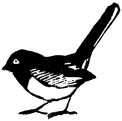
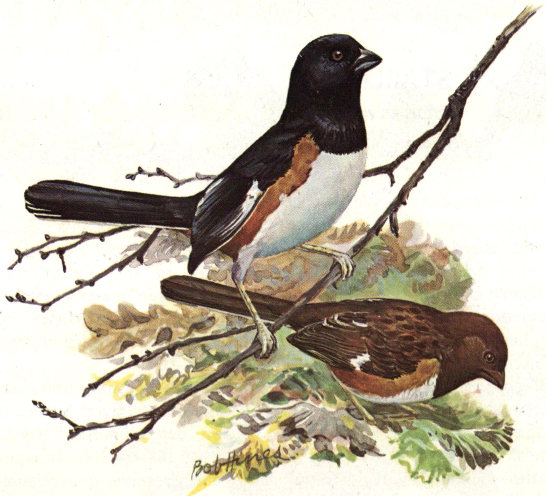
The bird remotely resembles the robin, although smaller and more slender. It frequents bushy places and is often detected by noisy rummaging among dead leaves.
It breeds in open brushy places, barrens, slashings, and forest edges from Canada to the gulf coast, and often ventures into landscaped yards.
Its call is a loud chewink, and the southern birds have a proper southern drawl, a slurred shrink.
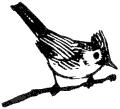
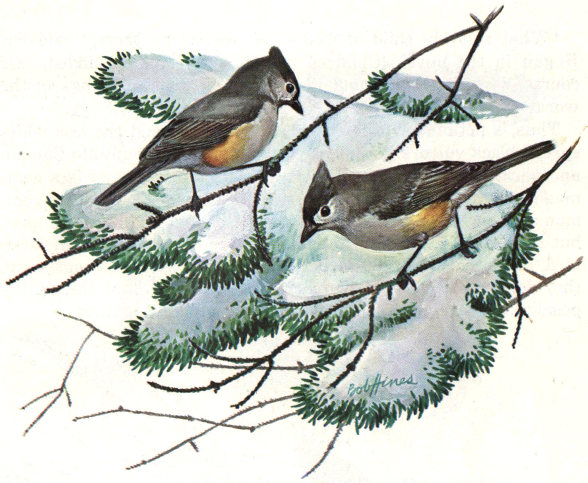
This sparrow-sized, active mite is often heard before it is seen. Its spring call of peter, peter, peter is a clear whistle, audible at some distance.
Insects are a large part of its food, but it takes seeds and nuts from a station quite readily, and is quick to scold if your feeder is empty. It also responds to “squeaking,” the technique bird watchers use to attract many species.
Preferring wooded areas, it appears in small groups in winter. It nests in cavities and bird boxes, and being non-migratory, often uses these same shelters for winter roosts.
The tufted titmouse is restricted to the eastern half of the country, but it has close relatives in the west.

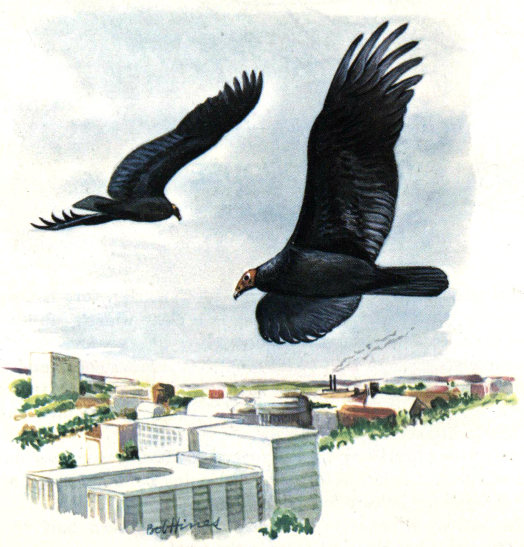
“What a lovely child of God it is, soarin’ up there,” said Fr. Hogan in the novel “Children of Hunger.” And he added, “Of course, down on the ground it’s a buzzard. Lots of things in the world seem to be like that.”
Thus, a fictional view of the turkey vulture and the less widespread black vulture. The turkey vulture summers up into Canada and permanently ranges the southern United States. It is a common sight along roadsides and sometimes above cities. These common carrion eaters are natural scavengers, and highly useful ones, but they are a little hard to admire except at a distance. A large bird, often more than 30 inches long and with great wingspread, they don’t need to be fed. Our driving habits and our careless disposal of garbage generally provide plenty of food for them.
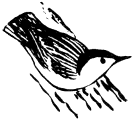
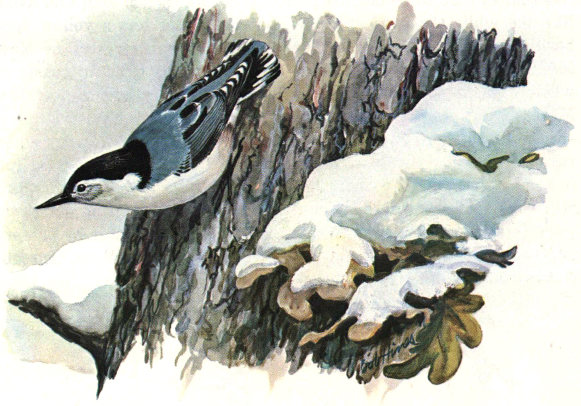
With a length of 6 inches, this resident of the United States, southern Canada and Mexico might readily be mistaken by a casual observer for a small woodpecker. But its call—an oft-repeated “yank”—is very unwoodpecker-like. Also unlike either woodpeckers or creepers, it climbs downward head first as easily as upward, seeming to defy the laws of gravity. “Nuthatch” was suggested by its habit of wedging nuts in crevices of bark so as to break them open by blows from a sharp, strong bill. The white-breast gets its living from the trunks and branches of trees, over which it walks from daylight to dark. Insects and spiders constitute about half of its food. More than half of its vegetable food consists of acorns and other nuts or large seeds. It’s a bird of the wooded suburbs, and will feed at sheltered stations offering suet, sunflower seeds, or nuts.
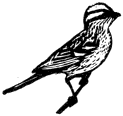
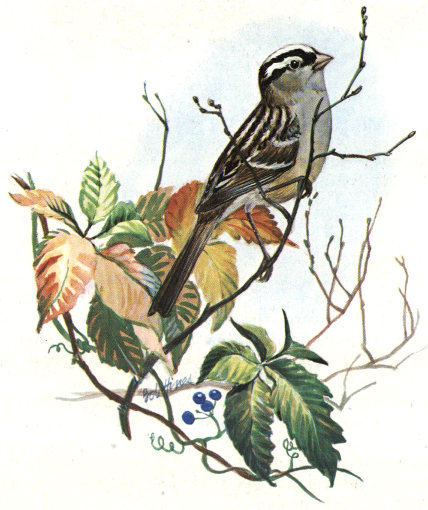
From tail-tip to beak, this perky flyer is 7 inches long and looks like the white-throated sparrow, but the latter has a yellow spot beside its eyes. White-crown breeds in the high country of New Mexico, Colorado, Wyoming, Montana, and the Pacific coast; it winters in the southern half of the United States and in northern Mexico.
This beautiful sparrow is numerous in the West, but rather rare elsewhere, so watch for it carefully if you’re in the East, for it is shy and retiring there. But the white-crown is bolder and more conspicuous in the Far West, often frequenting gardens, parks, and yards. Like most sparrows, it is a seed eater by preference—it appears readily at sheltered feeding stations. Insects comprise less than 10 percent of its diet.
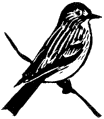
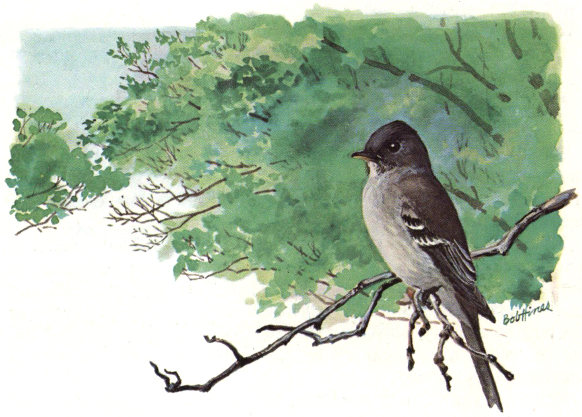
The bird of this painting ranges from the east coast through the Mississippi Valley, where its range meets that of the western wood pewee. They are hard to tell apart visually, although the songs are quite different. Both species also look like eastern phoebes, so spotting this bird with assurance requires some study. The names of all these birds are based upon their calls, and all are flycatchers.
The pewees like groves of mixed trees, and at twilight the eastern species sings a plaintive whistled song that is longer and more varied than its daylight song. You are much more likely to see or hear these birds in outer suburbia housing areas than in the inner city or on shopping center parking lots, since they require tall trees and cannot be heard above traffic noises.
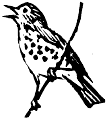
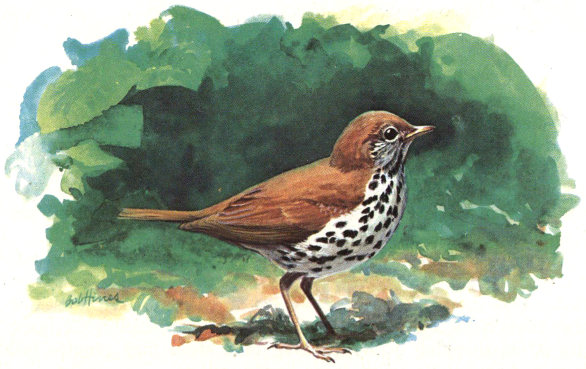
This bird is at least fairly common in suburban groves all over the eastern United States. Adults are a bit over 7 inches long and their song is like a flute phrase followed by a soft trill, heard usually at dawn or dusk.
There are a number of other common thrushes. The hermit has a wide range, summering up into mid-Canada and wintering in the southern United States and Mexico. Veery, Swainson’s, and gray-cheeked thrushes are also widespread. The wood thrush is the largest and probably the most citified, at least in terms of living in woody areas near cities. It is also the only one with a heavily spotted breast.
The nest is similar to a robin’s, but without so much mud, and is usually twenty-five feet or less from the ground in a tree or shrub.

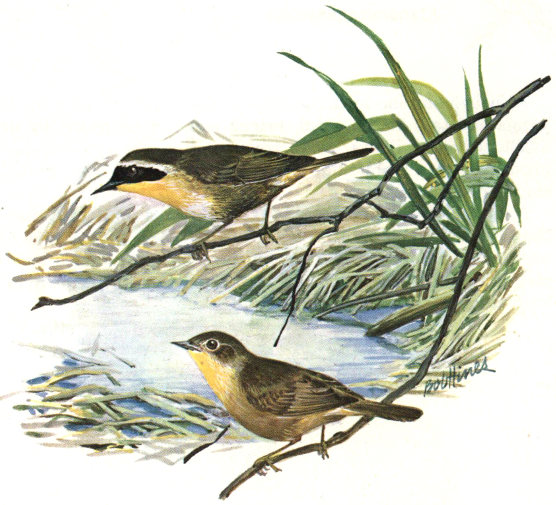
This is a gay little warbler that is abundant, at least in summer, across the United States and most of Canada wherever there are moist shrubby areas. It’s a permanent resident in southernmost United States and northern Mexico—and north up the Pacific coast to San Francisco. The yellowthroat lives in shrubs in moist areas, showing its distinctive markings to passersby. The female doesn’t have a black mask, but otherwise looks much like the male.
These warblers nest on or near the ground in moist areas and eat mainly insects, including plant lice; don’t look for them in the tops of tall trees. Adults are about 5 inches long. There are, of course, a lot of warblers over the continent, but the yellowthroat is widely distributed and widely admired. Keep your wet areas if you want to keep yellowthroats around.
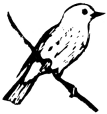
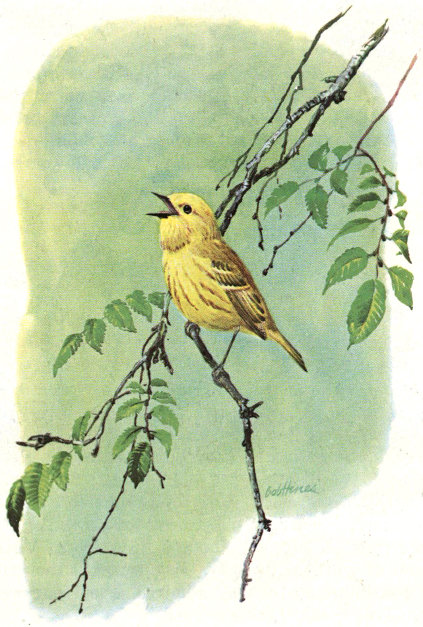
Although similar to the goldfinch, this warbler lacks the black wings and tail. Its cheerful, bright call can be heard by urban dwellers from willows, small trees, and shrubs growing on wet grounds and in residential areas that contain an open growth of small ornamental trees.
A tropic winterer, he breeds from the tree limit in Canada to the southern states. When plagued by cowbirds laying eggs in its nest, this warbler builds a second nest on top of the first, completely covering the cowbird’s eggs, and any of its own in the bottom layer.